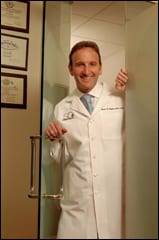Best Plastic & Cosmetic Surgeons | December 2013 Plastic Surgery Practice
A Series of Firsts
Randal T. Pham, MD, MS, FACS, Board-certified ophthalmologist
By Amy Di Leo
My patients joke that I give them 20/20 vision so they can see their wrinkles. Then they want me to iron out the wrinkles because they don’t want to see them.”
Board-certified ophthalmologist Randal T. Pham, MD, MS, FACS, does it all. As a leading researcher and clinical physician, he treats cataracts and other diseases of the eye. But in addition to his thriving Silicon Valley medical practice, he has a robust aesthetic practice where he offers blepharoplasties, facelifts, fillers, Botox®, and other procedures in and around the face.
As the founder of the Aesthetic & Refractive Surgery Medical Center in San Jose, Calif, he specializes in the treatment of cataracts and performs dozens of surgeries a week. Pham recently developed a new procedure for the treatment of cataracts that he believes will help him and his colleagues treat more difficult cases.
“Laser surgery for the treatment of cataracts has proven difficult for those with small eye sizes, but my new CO2 laser-based technique for making incisions has shown to be highly effective and safe,” he explains. “The CO2 laser was shown to be superior to cold-steel alternatives because it can cauterize and cut at the same time, therefore making the cut bloodless. The eyelid heals in one day. This CO2 laser procedure lengthens the eyelid to allow surgeons to fit an eyeball-stabilizing device onto the eye to keep it from moving, making laser surgery for cataracts safe and effective. The standard, current method for cataract removal, using a femtosecond laser to break the cataract into small pieces, has limitations for people with small eyes,” he adds.
The new technique will allow surgeons to safely remove the existing lens and replace it with a new, man-made lens. His research study on this new technique was published in the October issue of Modern Plastic Surgery. It opens up a whole new category of patients who will now be candidates for cataract surgery.
Pham explains, “The use for this surgical method extends to many types of difficult cases. They include people taking blood thinners, as the bloodless surgery helps to control bleeding. This method is also helpful for the nervous patient, who squeezes
his or her eyelids tightly during eye surgery, and for patients who find it difficult moving their eyes or moving their bodies during eye surgery. It will also help me operate on a patient with very deep eye sockets.”
Additionally, Pham has discovered that the CO2 laser can be used for other procedures. The wide applications open new opportunities for all laser refractive surgery.
“I can now open the side of the eye with the CO2 laser to allow wide exposure of the eye,” Pham explains. “This maneuver works for a vast number of eye surgeries, including LASIK. It is welcome news for my practice because we can now accommodate the most difficult patients, even those who were previously excluded from refractive surgery. Patients have been extremely impressed because the procedure is painless, the recovery time is very short, and there is no swelling or bruising,” he adds.
RESTORING SIGHT
Having years of experience with laser refractive surgery, Pham became the first surgeon in northern California to implant the ReSTOR® intraocular lens (IOL), which allows patients to see distance and close up without glasses. Pham says the femtosecond laser for cataract surgery works well with the ReSTOR IOL. As he explains, “The ReSTOR requires a perfectly round and centered opening in the capsule to allow the IOL to stay in perfect position. This advantage makes this type of lens more popular than ever before. Patients are thrilled when they were able to see far, near, and intermediate distances without glasses.”
Pham is also the first cataract surgeon in Northern California to use the Optimedica Catalys Precision Laser System for cataract surgery. The procedure allows for precise and gentle cataract removal. He uses all of these new technologies with the techniques he’s developed at his Aesthetic & Refractive Surgery Medical Center, an AAAHC-accredited center that he opened in 2011. He calls it the first training center on the West Coast to offer laser-assisted cataract refractive surgery using the Catalys.
Pham says all of these “firsts” add up to a better experience for his patients. “My team and I offer top-notch surgical care, which includes the placement of premium IOLs and all the latest treatment for cataracts. It is important for me that we provide a welcoming environment for my patients as well,” he shares.
Cataract surgery is a virtually painless procedure performed under topical anesthesia. Patients are able to enjoy greater visual acuity after treatment, and many are freed from dependence on glasses and contact lenses to perform everyday tasks.
“The center has received the highest score of accreditation with surveyors repeatedly stating they ‘would not hesitate to recommend their own family members to have surgeries at the center.’ This achievement was only possible because of the center’s motto: ‘Care for one patient at a time,’?” he explains.
Pham performs state-of-the-art laser cataract surgery with premium IOLs. He uses an advanced laser to make a tiny incision in the eye and directs the laser beam at the cataract. The laser energy gently breaks the lens into small pieces, which are extracted from the eye. Then, Pham says he places a folded-up IOL through the same incision, carefully positioning it and unfolding it inside the capsule, the bag that contains the cataract. The specific type of IOL used will depend on the patient’s unique vision needs.
THRIVING PRACTICE
Corrective vision surgery and treating eye disease makes up
60% of Pham’s thriving practice. He says the other 40% of his
practice is aesthetics.
“I perform 25 to 50 laser blepharoplasties combined with laser resurfacing per month,” Pham explains. “I use the most advanced laser technology, called fractionated laser resurfacing. This technology breaks the laser beam into small areas, allowing more room for the skin to recover completely since there are interspersed areas of normal skin not ablated by laser. These intact areas of skin are responsible for the fast healing after laser resurfacing.”
With a practice in the center of what he calls “Little Saigon,” it makes sense that Pham, who is a Vietnamese-American himself, pays special attention to the needs of his Asian-American patients. But Pham’s knowledge and experience spans the entire population.
“I developed implants for nose augmentation for Asian patients. These techniques were published in prestigious, international peer-reviewed journals. Recently, I added a Gore-Tex® implant to my minimally invasive facelift procedures. It is very popular in patients who want to have a quick recovery after surgery. I am also working to develop alternatives to Botox injections,” he adds.
Pham is the first ophthalmologist and oculofacial plastic
surgeon to receive the “Best Clinical Science Award” by the American Society for Laser Medicine and Surgery (ASLMS). He is the first Vietnamese-American appointed to the faculty of the Department of Ophthalmology of the School of Medicine at Stanford University. In 2003, Pham received the “Stanford Provost Honor” for his work on laser safety around the eye. A Phi Beta Kappa graduate from the University of California, Berkeley,
with a degree in biochemistry, his MD degree with “excellent citation” is from the University of California San Francisco. His oculofacial plastic surgery fellowship was completed under the mentorship of prominent surgeons Sterling Baker, MD, and David Hunter, MD.
“I have been recognized nationally and internationally for my research with lasers and was invited to submit a thesis to the prestigious American Society of Ophthalmic Plastic and Reconstructive Surgery (ASOPRS). Subsequently, I was inducted to the fellowship of the Society in 2008. I am honored to be among the company of a very select few who were elected into the Society’s fellowship without completing a formal ASOPRS Fellowship Program. These selections are reserved for those who are considered to be leaders in the field,” he explains.
Along with his own education and learning, Pham also believes in the importance of educating patients. “I established lasernews.com as a free service to provide non-biased information to patients who seek information about laser surgeries for the eye and the face. The editors are well-respected professionals who are leaders in their specialties,” he shares.
Randal T. Pham, MD, MS, FACS
Aesthetic & Refractive Surgery Medical Center
989 Story Rd, Suite 8063
San Jose, CA 95122
(408) 998-8110




